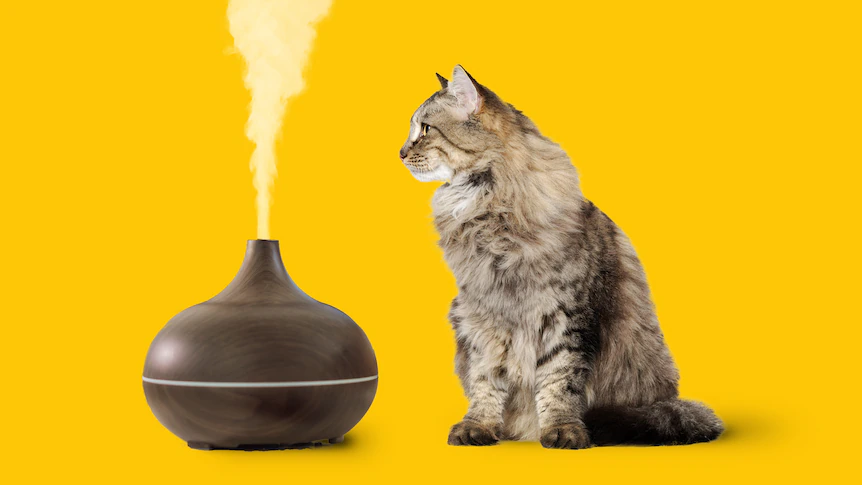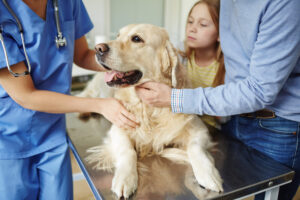Essential oils and oil diffusers could be harming your pet

As I wound down to the smell of lavender it never occurred to me my new bedtime routine could be harming my cat.
She often sleeps at my feet so would usually be in the bedroom at the time I would turn on my new oil diffuser.
But about a week into using the diffuser I inadvertently stumbled across the information that many commonly used essential oils can be harmful for pets.
While there are unfortunately, no known studies into how essential oils can harm our pets, the cases presented to veterinarians and animal poisons helplines show that when animals are affected, it can be severe.
“When a pet does come in due to an essential oil exposure the clinical effects are often serious and require hospitalisation and treatment,” says Nick Merwood, Poisons Specialist from the Animal Poisons Helpline.
Keeping a cat happy indoors
Keeping your cat inside is good for the wildlife, the cat and your wallet.
Is your diffuser active or passive?
Chief Veterinary Officer at PetSure and a specialist in pet dermatology, Dani Hoolahan, says understanding how your oil diffuser works is fundamental to understanding how they can cause harm.
“There are two broad categories of essential oil diffusers that you can buy,” Dr Hoolahan says.
“[They are] categorised as ‘active’ or ‘passive’ diffusers.”
Active diffusers
Active diffusers emit particles of the oil into the air creating a light mist. These include humidifiers and vaporisers, glass nebulisers and ultrasonic diffusers.
This mist may land on furniture, bedding or your pet’s coat and be ingested while grooming.
Passive diffusers
Passive diffusers include reed or evaporative diffusers, candle or heat diffusers.
“They emit a less intense aromatic scent as there is no mechanism forcing the essential oil into the air,” Dr Hoolahan says.
While both can be dangerous, active diffusers are the most concerning for our pets.
Dr Hoolahan recommends erring on the side of caution.
Renting with pets
While renting with pets is become more common, it’s not always easy. Here are some tips for making it work.
Which essential oils are the most dangerous?
Dr Hoolahan says that some of the more common essential oils best avoided around all domestic pets include:
-
* Clove
* Eucalyptus
* Geranium
* Pennyroyal
* Tea Tree
* Thyme
* Cinnamon
“[But] like with people, all pets are different — toxicity can also be species dependant,” she adds.
Cats
“Cats lack the essential enzymes in their liver to metabolize and eliminate the chemical compounds in essential oils,” says Dr Hoolahan.
“Therefore all essential oils have the potential to be toxic to cats.”
Oils she says are particularly toxic to cats include:
-
* Cinnamon and cassia
* Citrus (lemon, lime, grapefruit, orange)
* Clove
* Bergamot
* Basil
* Eucalyptus
* Geranium
* Lavender
* Oregano
* Peppermint
* Pennyroyal
* Pine oils
* Spruce
* Tea Tree
* Thyme
* Wintergreen
* Ylang ylang
Dogs
“Dogs do not have the same enzyme deficiency, but they can still be at risk of irritation or toxicity due to the concentrated nature of essential oils.”
Dr Hoolahan says it’s best to avoid:
-
* Clove
* Eucalyptus
* Garlic
* Geranium
* Juniper
* Pennyroyal
* Pine oils
* Rosemary
* Tea Tree
* Thyme
* Wintergreen
* Ylang ylang
Birds
And for our feathered friends, Dr Hoolahan says it is best to avoid the use of essential oils around them altogether.
Chief Veterinary Officer of the Animal Poisons Helpline, Dr Rachel Peacock agrees that “birds are particularly sensitive to any inhaled fumes”.
“[They] can become very sick or die even with low exposure to essential oils and artificial fragrances,” Dr Hoolahan says.
Experiencing pet regret?
While we should always try our best to take responsibility for animals in our care, sometimes we need other options.
Different ways pets can be exposed
It’s not just the species of pet you have, but also the way in which they are exposed to the oil that can be critical.
Ingesting oils orally
Ingesting oils orally is a definite no-no.
“Compounds contained in essential oils can cause chemical burns to the inside of the mouth or the oesophagus, as well as cause toxicity when they make their way into the pets’ body,” Dr Hoolahan says.
Inhaling oils
“Inhaling essential oils can cause respiratory problems in pets as the small airborne particles can irritate the respiratory system,” Dr Hoolahan says.
“Pets with existing respiratory conditions such as asthma or bronchitis are at greater risk of developing respiratory distress.
“The Animal Poisons Helpline has received several calls regarding small dogs and cats that have become lethargic and unsteady on their feet after being in enclosed spaces with diffusers for prolonged periods of time.”
Directly onto a pet’s skin
Dr Hoolahan says that “putting essential oils directly on the skin can cause chemical burns or irritation to the skin”.
“It also increases the likelihood that the pet will ingest the oil as they will most likely lick it off,” she says.
“For birds, applying essential oils topically can result in death.”
Common plants poisonous to pets
Bad news: your favourite houseplants and flowers are probably toxic to your dogs and cats.
Cartoon of three menacing-looking plants holding a pet’s collar to represent plants that are poisonous for pets.
What about other types of fragrance?
“Any artificial fragrance can be dangerous to pets,” says Dr Hoolahan.
“As the chemical ingredients could be toxic if inhaled, ingested, or lands on the skin.”
She says that includes fragrant candles, stick diffusers or plug-ins.
Passive diffusers are generally considered a safer option around the house with pets, but Dr Hoolahan still recommends you chat with your vet prior to use.
What to look out for — Signs of essential oil toxicity
One of the greatest risks of essential oils to cats and dogs is respiratory irritation.
Respiratory irritation can present as:
-
* Watery eyes and nose,
* Throat and nose irritation/burning,
* Nausea causing drooling and/or vomiting,
* Breathing difficulties shown by laboured breathing, increased breathing rate, panting, coughing or wheezing.
Dr Hoolahan’s advice, if you notice any of these, is to move your pet into fresh air, however if symptoms persist, or you’re concerned, consult your vet as quickly as possible.
Dog first aid
Here’s how to be prepared for when an emergency involving your pet happens.
Can you use oils safely as a pet parent?
Dr Peacock says that, “If people want to burn or vaporise essential oils in their homes, it is always best to use dilute solutions in well-ventilated spaces; and of course, avoid the oils listed above where possible.”
She says that approach should be safe, “as long as owners can prevent their pets from lying immediately next to or under the diffuser for long periods of time.”
Read the original article here: https://www.abc.net.au/everyday/are-your-essential-oils-and-diffusers-hurting-your-pet/100107686





